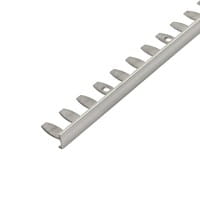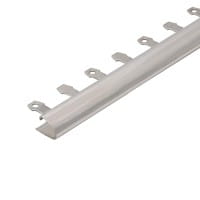Flexible tile profiles - flexibility meets functionality
When are flexible tile profile used?
Flexible tile profiles are special profiles used to install tiles on walls, corners and edges that are not straight. They are used to install tiles on corners, edges and curves where traditional rigid profiles cannot be adjusted. Flexible tile profile are often used on tiles with rounded edges and protect its edge contours.
Flexible tile profile are particularly useful when installing tiles on curved or curved surfaces, such as round showers, arches, columns or round walls. They allow for precise and clean tile installation and provide a visually appealing and professional finish.
These special profiles are available in many different designs to suit individual installation requirements. They can be selected in a variety of sizes, shapes and materials such as aluminium, stainless steel and plastic, offering a wide range of design options for any installation.
Flexible tile profiles in our assortment
We offer flexible tile profiles in different materials, designs, finishes and heights. Here, especially with our aluminium-profiles, the considerable height selection can be seen!
Our flexible profiles are available in the following heights:

- 2 mm
- 3 mm
- 4,5 mm
- 5 mm
- 6 mm
- 8 mm
- 9 mm
- 10 mm
- 11 mm
- 12,5 mm
- 15 mm
- 18 mm
- 18,5 mm
- 20 mm
- 22 mm
- 25 mm
- 27,5 mm
- 30 mm
aluminium: Our flexible angle profiles, quarter circle profiles and square profiles from aluminium, like their rigid counterparts, are created to serve as finishing profiles for wall and floors. The main difference here is that you can easily use them on curves as well. The Angle profile for bending aluminium natural for example, has a narrow visible edge and is available from us in heights between 2 and 30 mm. You can choose between unfinished and silver anodized surface in our store.
stainless steel: If you expect particularly high mechanical loads, we rather recommend our flexible angle rails made of V2A stainless steel. Stainless steel profiles are resistant to water, moisture and chemicals and retain their attractive appearance even with frequent use. In addition, stainless steel profiles are very hygienic and easy to clean. Here you can choose between unfinished and brushed surface, e.g. the Angle profile for bending stainless steel brushed.
Brass: Furthermore, we also have a flexible angle profile made of brass in our range. Brass profiles have a warm and elegant appearance and are ideal for indoor use, especially in living areas and foyers. The DURAL Angle profile for bending brass due to its material, is a very durable and resistant product that can be used in harsh environments due to its excellent mechanical properties.
Application & processing of bendable tile profiles

Always select tile profiles 1-2mm higher than the tiles you are going to install. They are suitable for safe tile edge protection as well as for clean separation of different coverings. The profiles can be bent by hand without further ado, but we recommend the use of a curver to make your work easier and to improve the precision even more.
Curver for bending tile profile
A curver is a bending device to make your work with flexible (bendable) tile profiles easier.
The Curver with crank is suitable for all tile profiles for bending, as well as for bending selected skirting strips (unfortunately this is not possible with the skirting strips with cable channel ) and transition profiles in T-shape.
Instruction manual Curver:
- The Curver is fixed to the countertop or similar with the enclosed screw clamps.
- The bending disc is moved away from the holding rollers with the turning knob. The profile is then inserted so that the profile rests against both holding rollers. (The first 15 cm are bent manually or removed). Then loosen the guide roller with the enclosed wrench.
- The profile is pre-bent to the desired radius by moving the bending disc using the turning knob.
- Now the guide roller is pressed up to the profile and tightened in this position. Then the bending disc and thus also the profile are moved up to the guide roller again by means of the rotary knob until a slight clamping effect is achieved. To prevent the profile from twisting and damaging the bending roll, the profile must be fixed with the flat holders.
- By turning the bending roll and simultaneously guiding the profile, a constant radius is now obtained.
- If the profile is to be bent with the punching facing outwards, the two flat holders must be repositioned. Guide roller and holder rollers must have the beveled side up.
A detailed instruction manual for the Curver & the Curver with crank can be found in the article itself!








